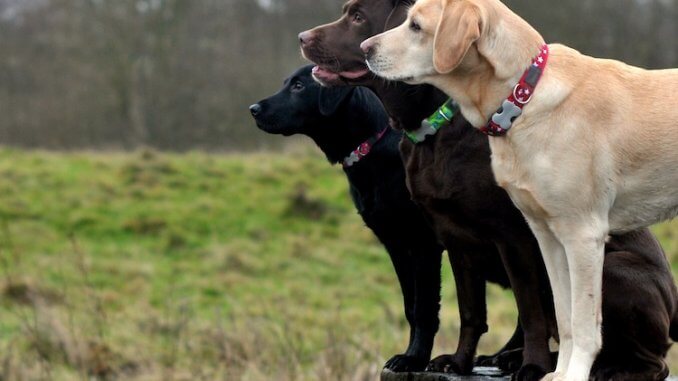
Labradors are the classic family dog, with bundles of energy and playful personalities, it’s no surprise they are the most popular breed in the US. Congratulations you’ve chosen a winner, welcome to the world of Labrador retrievers!
Having a puppy is a big responsibility, a lot of effort and patience is required to raise a sociable family companion. Lab puppies are full of mischief and fun, so it’s important for their parents to have similar personalities!
There are plenty of things to do before bringing your dog home.
You should think about the household rules, set up safe/crate areas, make sure you’ve got plenty of toys and chews (Labradors love to chew), and have puppy-proofed the entire house.
This guide will cover all the basics a Labrador pup needs to learn, training Labradors, and how best to do with a seven-stage plan.
TABLE OF CONTENTS
Training a Labrador Puppy
Labrador training should start straight away. Keeping it fun and consistent will help to build a trusting relationship.
This is particularly important with a breed who is so in tune with us, he is learning with every interaction we have! It’s no accident that Labradors are commonly used as service dogs; they are quite smart.
Labradors are renowned for being massively food motivated. 24% of Labradors have a genetic mutation which is associated with increased food motivation.
Training lab puppies using positive reinforcement (such as food or play) will create a trusting relationship and reduce the chances of them showing undesirable behaviors!
How To Potty Train A Labrador Puppy
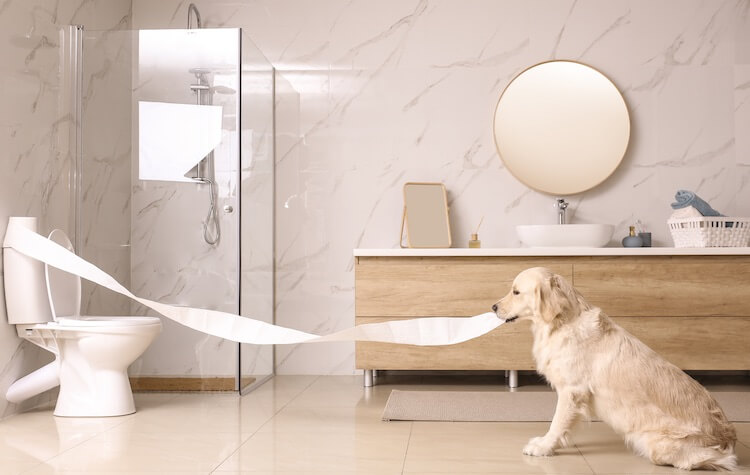
Potty training a Labrador puppy is usually the first thing you will want to start with. It is best to avoid using pads or indoor toileting areas, as this is very confusing for a dog.
Instead, you should take your Labrador out to the yard regularly using a set routine. You should take your puppy to the garden:
- After play times
- After meals
- After waking up after a snooze
Once you are outside, simply wait for them to toilet. Remember Labradors love to play, so it won’t be unusual if your pup gets distracted by plants or toys. Wait him out to get bored, and he’ll eventually go-potty. When he does, reward him with a nice treat.
Here’s a potty timetable for an eight week old Puppy; these times can be gradually extended as your puppy gets older.
| Time | Activity |
| 6:30 – 7:30 | Wake up, Potty, Zoomies and play, Breakfast, Potty! |
| 7:30 – 8:30 | NAP |
| 8:30 – 9:00 | Wake up, Potty, Training (sit/recall/loose lead) interspersed with play, Potty! |
| 9:00 – 11:00 | NAP |
| 11:00 – 12:30 | Wake up, Potty, Lunch, Potty, Play time, Potty |
| 12:30 – 14:00 | NAP |
| 14:30 – 15:30 | Potty! Training interspersed with toy play, Potty! |
| 15:30 – 16:30 | NAP |
| 16:30 – 18:00 | Wake up, Potty! Toy play, self-play, Dinner, Potty |
| 18:00 – 19:00 | NAP |
| 19:00 – 20:00 | Wake up, Potty, Play (chewing), Potty, Sleep |
If your lab puppy has a mishap inside (and it will happen during the first month so be prepared), avoid shouting or punishing him. He won’t understand what went wrong!
Instead, clean up the mess and remind yourself to take him out more regularly.
As he gets older, your Labrador will learn to hold his bladder for longer, as well as knowing that it’s a really good thing to ‘go-potty’ outside, rather than inside.
Train A Labrador Puppy Not To Bite
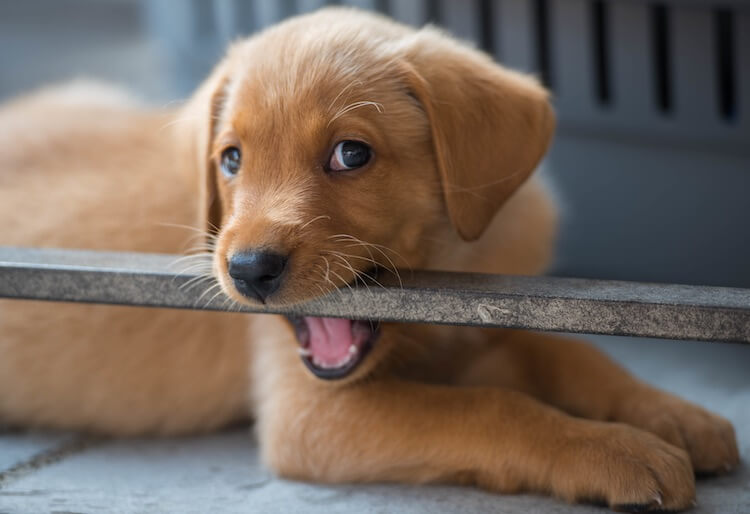
Teaching your puppy not to mouth or bite is high on the agenda for puppy parents, especially those with children in the house.
Puppies are notoriously energetic and playful, but with this comes the tendency to use their mouth. This is perfectly normal, and all puppies will use their mouth to explore, however it’s up to you to gently teach them that this is not the way they play.
Most puppies will mouth when they are over-tired, hungry, or need the toilet, so make sure you’ve got your puppy into a good routine of sleeping, meals spread across the day and plenty of toilet breaks.
It is best to first try to direct your puppy onto a toy when interacting with them, so that they learn to target toys rather than hands when playing or being stroked.
Labradors tend to love big, soft toys, given their retriever roots. So ensure that toys you have are big enough to fill their mouth comfortably to get a good grip on.
Should your puppy want to play with hands instead of a toy (which isn’t uncommon), it is best to withdraw all attention from your puppy and walk away. This will teach your puppy that this type of interaction does not get further play or attention.
It is very important to make sure that no-one in the household is rough housing your lab, as this will be confusing whilst they learn not to bite!
With consistency, over the first four to eight weeks, mouthing should reduce and the majority of mouthing should have stopped by six months old.
When you start training, keep in mind, as well as losing and gaining teeth at different rates, all puppies are individuals and will vary! You should make sure that they have plenty of chew toys for your pup to gnaw on and relieve their discomfort – frozen tea towels can be a great comfort for sore gums.
How To Crate Train A Labrador
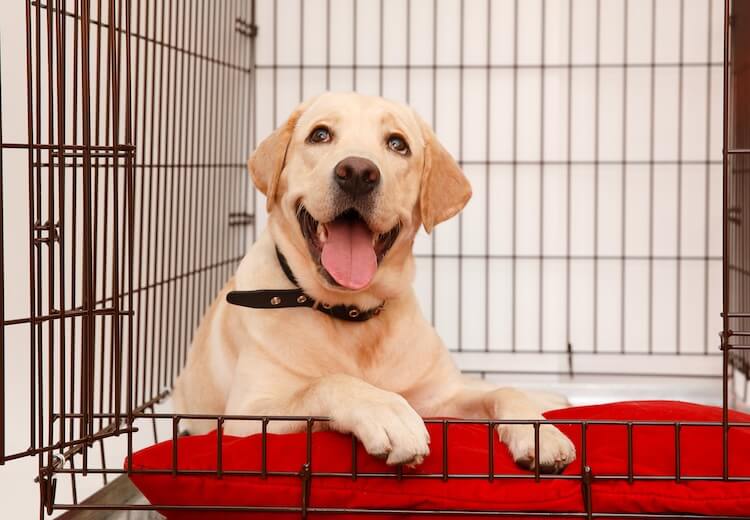
Crate training lab puppies is a great way of ensuring they are safe and secure when you are not around to supervise them. This will also create a snuggly area for them to withdraw to when they are tired of family life!
It’s tempting to initially fill the crate with a fancy bed, but this won’t last long with a Labrador puppy. Old duvets or blankets are ideal, and you should make sure to place his crate in a quiet spot where he can see his family.
The best way to introduce the crate is to hide ‘surprise’ treats in there for him to find on his own accord. This will teach him that this is a nice place to go of his own choosing and will spend more time there.
You should also feed his meals in the crate (ideally utilizing some sort of slow feeder like a frozen Kong) to create a positive association.
After the first week of building a positive association, try to slowly extend the time spent in the create with the door closed. You should continue to provide his meals in there and close the door while he eats. As soon as he finishes the food, open the door.
You can then extend the time the door is closed after he’s finished his meal. For the first few sessions you might pause a few seconds after he’s finished before opening the door so that he learns to cope with the door being closed, and then gradually build up that time over days.
You can use the labrador crate training schedule below for guidance:
| 8 weeks | Puppies should only be locked in their crate overnight (ideally next to you to avoid distress) |
| 12 weeks | By this age, it should be possible for the puppy to be left for 30 minutes |
| 14 weeks | With continued training, a puppy could be left for up to 1 hour |
| 16 weeks | Potentially they can reach 2 hours by this age |
You want to avoid him showing any signs of distress. If he starts to cry, wait momentarily for a quiet moment, before opening the crate door and then go back a few stages with the training!
The amount of time a puppy should spend in a crate will depend on how comfortable they are. Adult dogs should not be left locked in a crate for more than 4 hours at a time.
Teaching Your Labrador To Come (Recall)
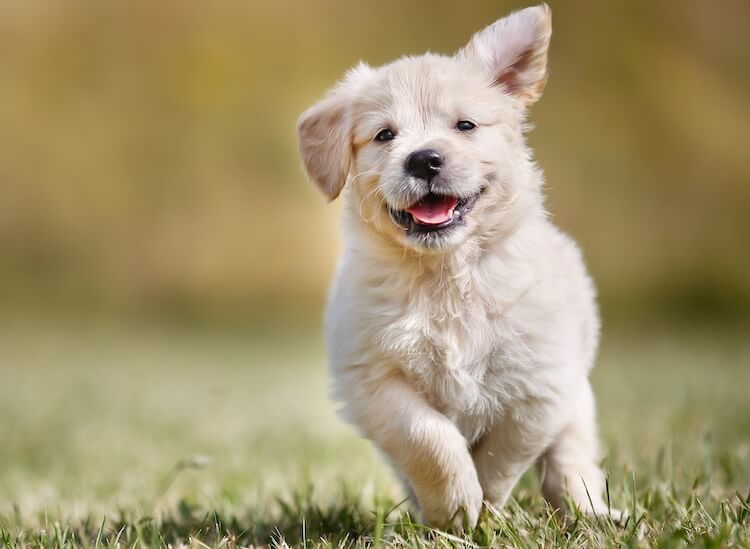
During Labrador puppy training, one of the most important skills to master early-on is a recall. This is a very useful skill as it can retrieve your Labrador from the depths of mischief.
As Labradors tend to be enthusiastic meeting other dogs and people, a solid and consistent recall is a must to ensure you can call your dog away from those who do not wish to interact.
Choose a word (or use a whistle/noise) and exclusively use this for recall training your labrador:
- Start by teaching your puppy that this “cue word” = delicious food. All Labrador puppies love their food! For three days, say your “cue word” and immediately deliver food.
- After a few days, if your puppy is walking towards you, start saying the cue when your puppy is further away, and then giving them a food reward when they arrive at your feet! This will help associate speedy responses with the cue.
- Once your puppy understands the cue, without having done any direct training, start by asking them to come when they are looking at you with a little bit of distance between you. Make sure you only use their recall cue when they are not distracted and are going to be successful in responding!
- When they get the idea, you can start using the cue in various rooms around the house, still make sure your puppy is focused on you before using the cue.
- When they’ve got the idea of this around the house and garden, you can add in a few distractions- if you’ve got children, get them to run around whilst you practice some recalls – or ask your puppy to come to you when they are sniffing in the garden!
- You can then start proofing the cue out on walks. Remember, your puppy will find this hard, so attach a training long line to their harness so they can be off exploring safely whilst you build up their training!
Remember when training labs, only use their recall cue when you are 80% confident they are going to come back to you. Recalling away from playing with other puppies is a really hard task, it would be like leaving a party just as it’s starting!
How To Leash Train A Labrador
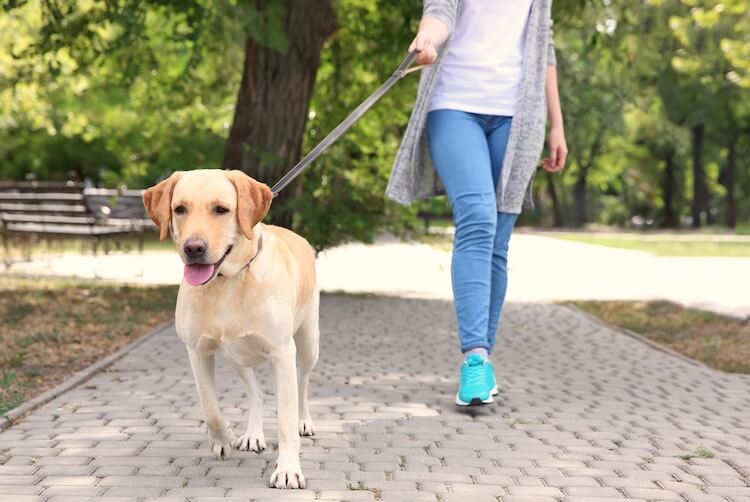
To ensure your walks are enjoyable for both of you leash training your labrador is fundamental. This skill incorporates lots of different things your puppy has to understand and learn:
- They can’t always get to where they want to get to straight away, and they have to learn to cope with this inherently frustrating barrier
- Spending time next to mum/dad is the best place to be as they earn rewards
- Pulling on the lead doesn’t get them anywhere and results in the end of forward movement
Combining these three lessons together, will train your labrador to master loose leash walking! Training labradors to walk nicely across lots of different situations and contexts can take months of hard work. But, with a large breed like a Labrador, it’s essential.
Firstly, reward your Labrador with food for being close to you after you attach their lead. We want to reward them regularly for being close to us or for walking alongside us. This will help to train them that ‘hanging out and focusing on mum/dad is a good thing’.
If your puppy does start to pull (and remember that adult Labradors can weigh up to 80lbs), stop walking immediately. Wait for them to come back to the ‘fun zone’ next to your side. You can achieve this by luring them with a treat, reward and then start walking forward again.
When your puppy wants to get to something and can’t, reward them when they turn back onto you!
It is completely normal for dogs to sniff and explore and we don’t want to stop this as it’s an important part of ensuring they are fulfilled! Ensure that their walks are balanced between learning to leash walk and having some ‘free’ time to run, play, and sniff.
As with all labrador dog training, start in a boring place to at first, and then gradually increase the distractions.
Start in your yard with your eight week old puppy and when they are allowed out (after their injections) for a walk, they’ll be ready for this step in their training!
How To Train A Labrador Puppy To Sit & Stay

As with all of the skills in this guide, sit and stay are both very important to teach your labrador. Sit is a really useful thing to train, as it’s a great alternative to jumping up, or just simply as a polite behavior to teach your puppy to do in order to ‘ask’ for things.
Teach Your Labrador To Sit
- Show your puppy a treat and hold it in between your thumb and first couple of fingers
- As they sniff the treat, gently lift your hand up and backwards over their head slowly
- Usually puppies will tend to plonk their bottom on the floor, at this point, reward them!
- Repeat this a few times until it’s smooth
- Once they’ve learnt this hand signal, you can now add the word ‘sit’
- Say ‘sit’ clearly and then move your hand in exactly the same way, so that your puppy learns the cue
- Over lots of repetitions, your puppy will be able to ‘sit’ with simply the word!
Keep your training sessions very short. Try to only do 10 in a row before having a break, Labradors tend to want to keep busy and move between activities quickly! They are also growing very quickly and you should protect their joints from too much repetition or activity.
Train Your Lab To Stay
- Ask your puppy to ‘sit’, don’t reward them yet though
- Then say ‘stay’ with an open palm and take half a step back
- If your puppy has stayed in the sit, reward them!
- If they move with you, repeat the first part, but take a smaller step, or rock backwards instead
We want to train our lab puppy that stay means maintain position regardless of mum/dad’s movement. For doing this they get a reward!
Build up to how much movement you can do (star jumps are a great test) and how far away you are from your puppy. This needs to be done really gradually – the fewer times they ‘break’ the stay, the better!
Remember to build up distractions whenever training your labrador with something new, start somewhere where the puppy can concentrate easily and then build in more distractions!
Training Summary
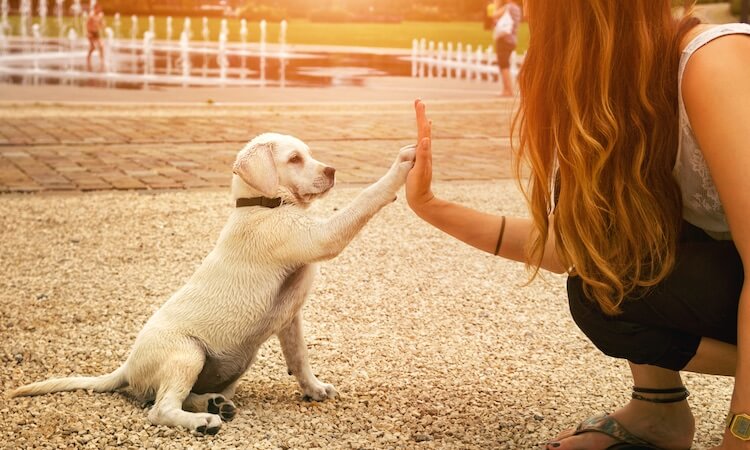
As a pup parent, you will be super busy running around after your mischievous Labrador puppy!
Most of the training suggested can be incorporated into routines. For example, crate training is at every mealtime. The other training are great ways of tiring your puppy out and keeping them mentally stimulated so can be sporadically done throughout the day!
Keep sessions short and spread across the week rather than long sessions! It can take weeks for puppies to master potty training or crate training – so as with all Labrador training, be patient and consistent.
Don’t feel you have to do it all by yourself, enrolling you and your lab puppy into a good quality, positive reinforcement training school is a great way of learning techniques, socializing and gaining support from fellow parents.
A lot of trainers offer home consultations, and this can be a great way of helping with any specific training hiccups. Let us know if you have any questions that arise when training your Lab below!

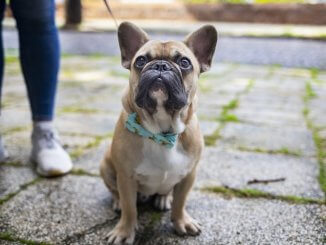
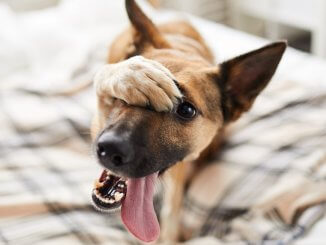
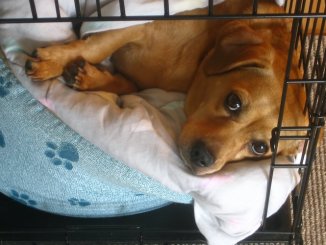
Thank you. This is helpful. We are getting an Australian Labradoodle next month and I suspect these tips and advice for labs is appropriate for our doodle even though he will weigh less than half that 80 pound lab!